Would you like to grow moringa and learn how to keep it alive through winter? Today I’ll share how we protect moringa trees from frost, using just scrap wire fencing and fall leaves.
Some of you may be familiar with a tree called moringa (Moringa oliefera) which is one of the world’s most beloved medicinal trees.
Moringa is a really good nutrient accumulator, it has complete protein in it, is good for animals, is good for people, you can make tea out of it, you can add it to your food, and it makes an edible fruit if you’re in the right climate (though I’ve never had it growing long enough in the right climate to get many pods).
The problem with moringa is that it is a true tropical tree. If it touches 32 degrees the thing melts.
Still, there are plenty of gardeners growing moringa into Zones 8 and 9. I would venture to say that what most of these gardeners do is just let the moringa tree freeze down to the ground and hope it grows back from the roots the ground the next spring. More ambitious gardeners will chop it down and mulch over the roots, but I am even more ambitious than that.
A Better Way to Help Moringa Survive Winter Freezes
Some years ago we figured out a method for preserving moringa trees through frosts. It worked great on the border of zone 8/9. We’re gonna try it here again in Lower Alabama (zone 8) and I am absolutely convinced that it will work. Why? Because just down the road from me I have a friend whose moringa trees came back from the roots after a cold, harsh winter (by Alabama standards, that is).
I know that if hers tree came back from the roots with a bit of mulch, mine will definitely going to come back if I practice this method and they’re going to be way more vigorous than if I just let them freeze to the ground.
The Method
This moringa tree was grown from seed planted in the spring and it is nine feet tall i would say, so we’re gonna have to cut it down to size.
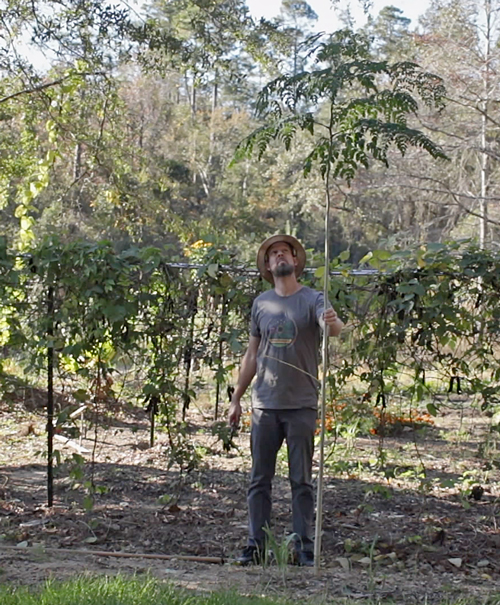
This moringa tree was planted from seed this spring!
Snip!
Now we have our trunk and we’re just going to stick a little ring of wire around it…
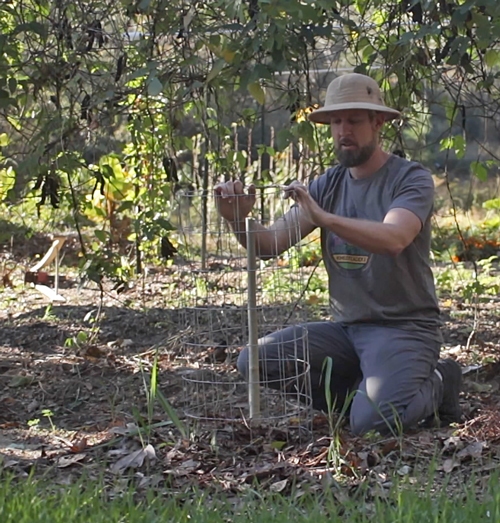
…and then stuff the wire with leaves.
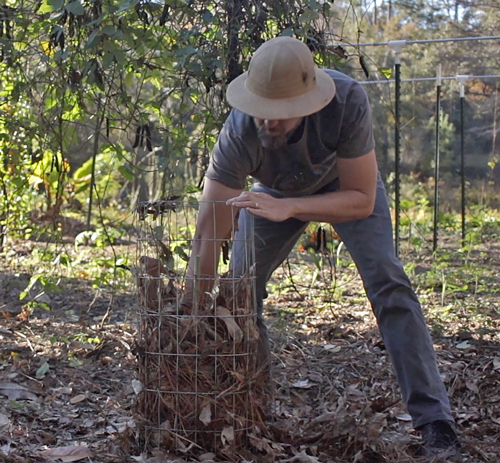
That’s it – that’s all you have to do.
This right here is providing enough insulation to keep that trunk from freezing.
Now if i was really worried that it was going to get super cold I could mulch the ground around this too, but that’s not necessary for a zone 8/9 winter. It doesn’t get cold enough to really damage the tree roots here.
If you’re an area that has wet winters, put something over the top of the ring of leaves to keep water from running through on the inside and making it a sopping mess. This is particularly a problem if you use straw because it can get clumpy and wet around the trunk.
Moringa is a tropical tree incapable of growing when it gets cold, so if it gets wet in winter it’ll just sit there and rot without being able to grow out of it or keep itself from dying. I’ve had this happen before. If it’s going to be a really wet winter I just put something over the top of it. I could put a big barrel over it if I wanted, or a tarp or a trash bag, it doesn’t matter.
Growing Moringa in Cold Climates
Now if you are in a colder climate you might be able to keep moringa alive, say in Zone 7, by making the ring bigger.
Make a bigger ring, stuff in a bunch of fall leaves, cover the whole thing really well, and now you’ve got all that air space in there and it’s probably going to live!
I can hear you asking right through the screen, “why protect the trunk instead of just letting it freeze down and come back?”
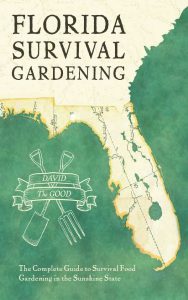 Well, I found through my experiments growing moringa in non-tropical climates that if you protect the trunk, there’s a lot more life and sap in the tree after winter. When it comes to the next season they grow more vigorously, they grow faster, and they produce you leaves much quicker if you can protect the trunk. If moringa freezes all the way down to the roots it regrows these little weak stems and then they have to thicken up and grow before they really give you a good yield.
Well, I found through my experiments growing moringa in non-tropical climates that if you protect the trunk, there’s a lot more life and sap in the tree after winter. When it comes to the next season they grow more vigorously, they grow faster, and they produce you leaves much quicker if you can protect the trunk. If moringa freezes all the way down to the roots it regrows these little weak stems and then they have to thicken up and grow before they really give you a good yield.
The more the trunk you can protect the stronger it comes out later, so I’ve taken to protecting the trunks unless I have a lot of trees. If the rings are a little loose on the ground, you can stick some little tent pegs or something in there to hold them. If I have bigger rings, they sit really easy.
For those of you who are going to ask “what are you going to do with all this all this moringa that you just pulled off – that stuff’s crazy expensive!?” well, we’re going to dry it and we’ll keep it in the house.
I’ve written a lot on this tree. I have written about it in Totally Crazy Easy Florida Gardening, I’ve written about it in Florida Survival Gardening, I’ve written about it on this blog, I probably wrote about it in Grow or Die – I don’t even remember anymore! – but this tree is super useful.
 If you are in zone probably six and north it’s going to be hard to keep it alive because your ground freezes too and that is tough. In that case I would grow it as an annual. You saw how tall that thing was one year’s growth and it wasn’t even in a particularly good spot! It had too much shade, it had terrible soil, and it still hit 9 feet! You can easily get them to 10 or 20 feet in the first year unless you have a short growing season without a lot of warmth. Moringa likes it warm or hot, so if you have hot and humid summers, like in Tennessee or whatever, no problem you’ll do just fine growing moringa from seed! Just treat it like an annual unless you want to put a great big ring around it and see if you can keep it alive through winter. Also, if you live in a cooler climate you can put a moringa tree in a big pot and bring it into the house. Cut it down short so you’ll be able to move it in and out. Pruning it won’t kill it!
If you are in zone probably six and north it’s going to be hard to keep it alive because your ground freezes too and that is tough. In that case I would grow it as an annual. You saw how tall that thing was one year’s growth and it wasn’t even in a particularly good spot! It had too much shade, it had terrible soil, and it still hit 9 feet! You can easily get them to 10 or 20 feet in the first year unless you have a short growing season without a lot of warmth. Moringa likes it warm or hot, so if you have hot and humid summers, like in Tennessee or whatever, no problem you’ll do just fine growing moringa from seed! Just treat it like an annual unless you want to put a great big ring around it and see if you can keep it alive through winter. Also, if you live in a cooler climate you can put a moringa tree in a big pot and bring it into the house. Cut it down short so you’ll be able to move it in and out. Pruning it won’t kill it!
The other option is to stick it in a greenhouse and that kind of gets expensive.
To re-cap: Further north I would just grow it as an annual or put it in a pot. If you’re in Zone 7 I would try making really big ring of leaves to keep it alive or maybe put it in a pot. In Zone 8 and 9, just protect the trunks like I did in the video and you get much better regrowth than if you let it freeze all the way to the ground and lose all that trunk and the sap that’s inside of there and all those growth buds.
If you are in zone 10 or 11 or totally tropical you can grow this tree year round. If you’re in zone 10 and get one of those rare frosts, it’s not a big deal. You can just shrug it off and it’ll lose a few leaves. In the true tropics where it doesn’t freeze at all, moringa is a year-round survival forage crop, a regular vegetable, a chop and drop tree, and all that kind of thing. It’s so easy to grow in that climate.
Finally, I almost always start moringa trees from seeds instead of cuttings. We found that cuttings are just kind of weak and they don’t do great compared to one started from seed. The only time I would consider cuttings is if I had a bunch of trees that I wanted to stick around the edge of a sheep or a goat enclosure or something. Maybe I just wanted to ram a bunch in or make a hedge structure or something. I’d just punch holes in the ground and stick them in, like I used to do with Gliricidia sepium.
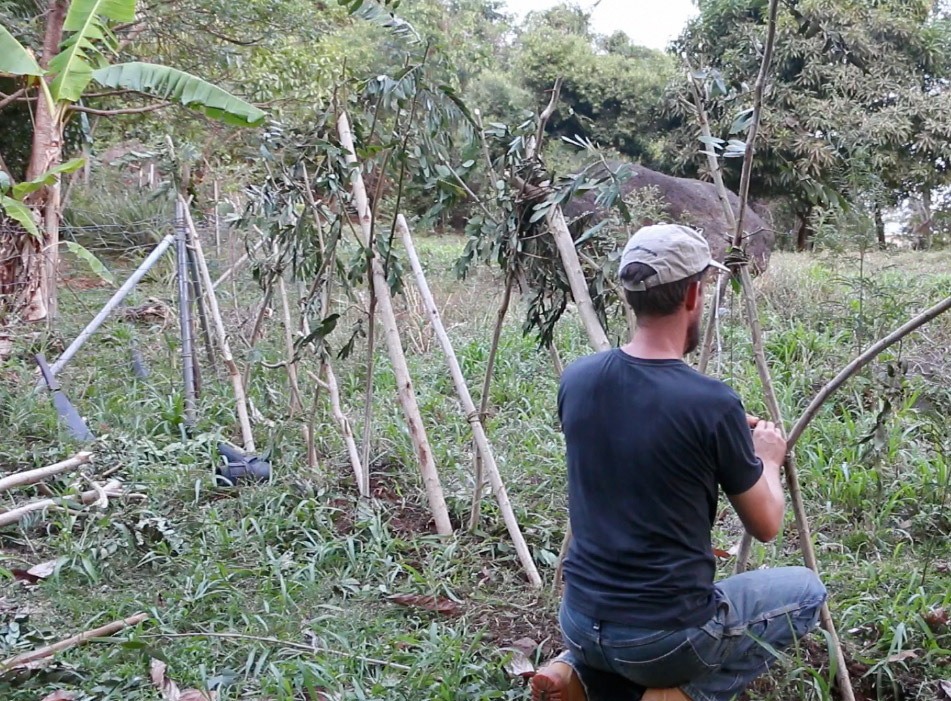
Even if you grow moringa as an annual you get a pretty good yield of leaves. The seeds aren’t that expensive, so try it!
Moringa is medicinal, easy to grow and full of vitamins. When you cook moringa it loses its weirdly horseradishy flavor and is a quite decent addition to many dishes.
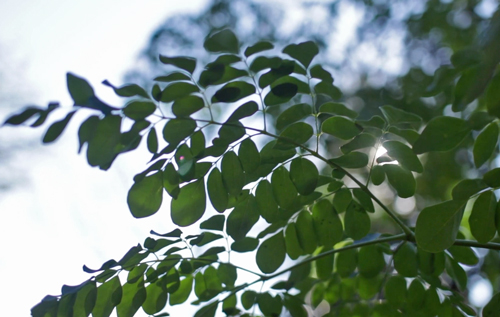
Protect moringa trunks through winter freezes and you’ll get even better harvests.
Happy growing!

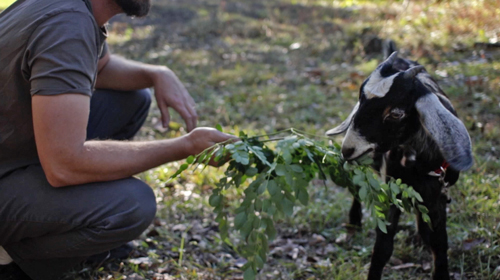
9 comments
I wonder if this will help our Pakistani mulberries? They don’t seem to like our zone 8b. The keep hitting the reset button every year and at this rate we’ll never see fruit. Any ideas?
I think it’s a great idea – protecting the trunk, and that graft union.
I think if you protect the grafts they’ll do better. Though they may just not like your climate.
California is going through an unprecedented cold temperatures right now. I’ve been worried about my two trees that I have. Well one is grown from seed and is only 5 feet tall and it doesn’t look good right now. The other I purchased pretty cheap from home Depo and it also looks bad. We are having cold wet winter frost now. So I poured warm water and covered both the trunks with a fabric that’s meant to shield from extreme temperatures. One is in a pot and other was already planted in the ground
I lost my protected moringa tree over the winter. Wet and too cold – that fried it. Some years are tough.
Same here.. from San Diego. Had 2 trees grown from seed last year, one 7ft and other one 5 ft tall, planted in ground. After the cold/wet winter, they look like 2 stumps now without any leaf/new growth. I scratched stem a bit and they seem green & moist. How to tell if they would survive (or) dead? Any ideas/steps to revive them? Any help/pointers would be appreciated. Thanks in advance.
Not sure if I could upload some pictures of the trees.
Thank you for this I am living n zone 7 and I’ll try to grow morninga treee
Good luck.
Comments are closed.